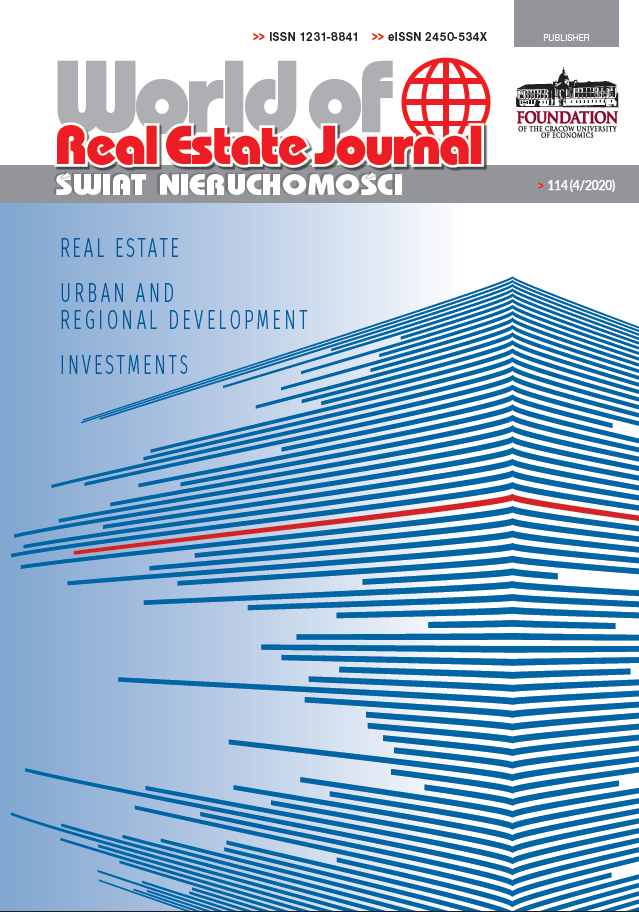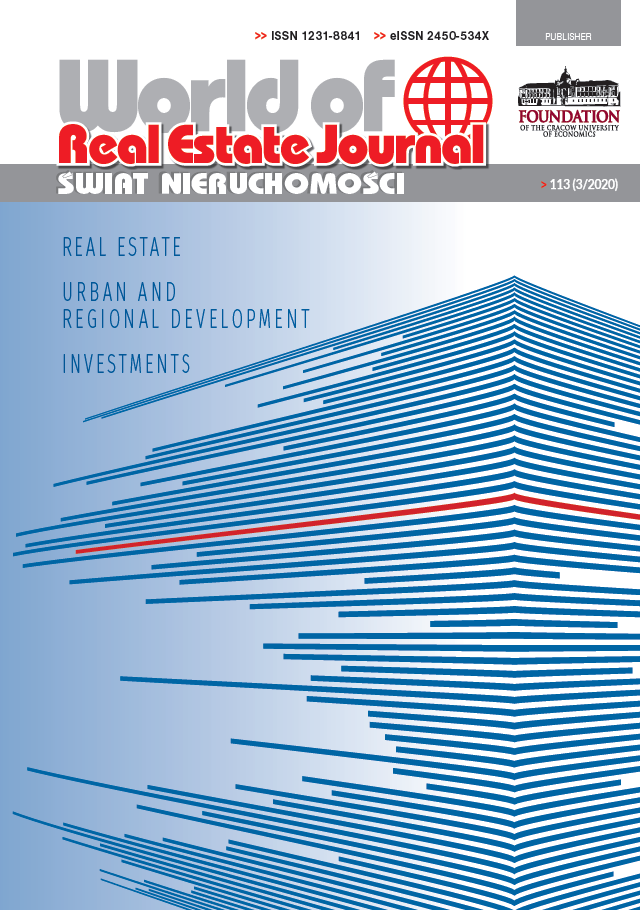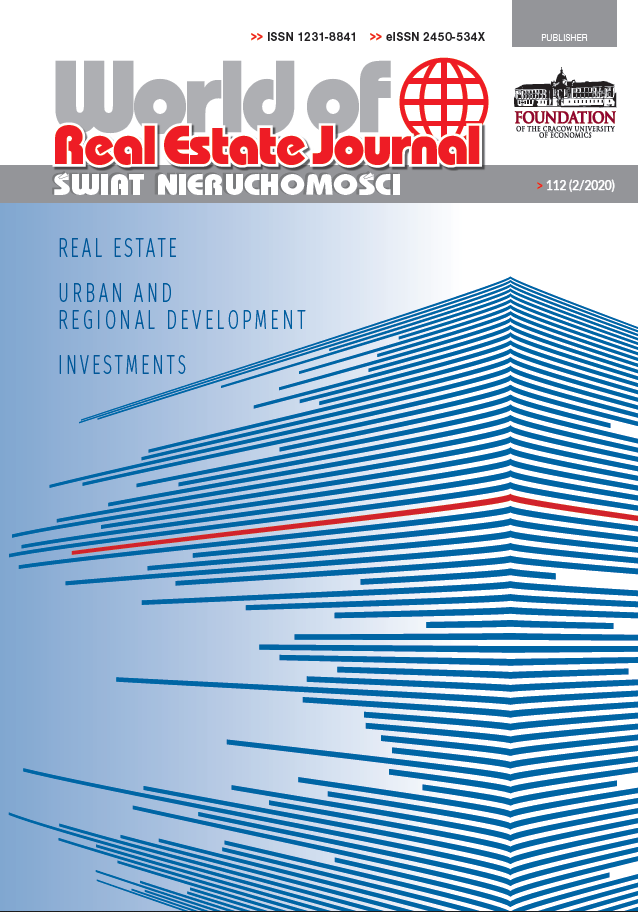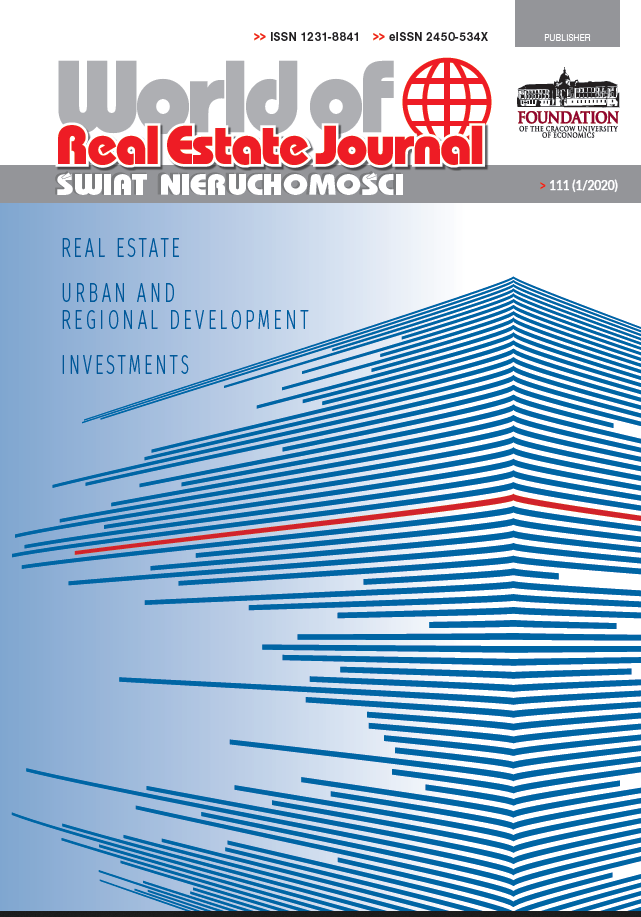SPATIAL DEVELOPMENT
1) Bogusław Luchter - Changes in the Distribution of Industrial Areas in Kraków as a Result of the Implementation of Market Economy Principles
2) Jacek Kiełducki, Małgorzta Blaszke - The Intended Use and the Planning Rent in Local Spatial Management Plans
MARKET
3) Bogumiła Powichrowska, Aleksander Prokopiuk - Trends of the Real Estate Market from the Perspective of Developers in Podlaskie Voivodship
REVITALIZATION
4) Paulina Basińska - The Influence of Indicators Used in Delimitation Diagnosis on Designation of Defeated Areas and Urban Regeneration
INWESTMENT
5) Małgorzata Blaszke, Maciej J. Nowak - Local urban Standards and the Issue of Disability of Public Authorities
FINANCE
6) Damian Kaźmierczak - Financing the Operations of Development Companies Using Convertible Bonds on the Example of the Polish Real Estate Market
MANAGEMENT
7) Bartłomiej Marona - Legal, Organizational and Methodological Aspects of Public Real Estate Management
CHANGES IN REAL ESTATE LAW
8) Maciej J. Nowak - The Transformation of Perpetual Usufruct into Ownership DOWNLOAD
CONFERENCES
9) Ewa Kucharska-Stasiak - Scientific Vonference "Building the Future - New Processes, Transformations and Trends on the Real Estate Market" (Łódź, 28-29 March 2019) DOWNLOAD
SUMMARIES
Bogusław Luchter - Changes in the Distribution of Industrial Areas in Kraków as a Result of the Implementation of Market Economy Principles
The purpose of the article is to assess changes in the distribution of industrial areas and their role in the spatial structure of Kraków in the market economy conditions. Kraków has been chosen as an example: a city in which industry constituted a key economic function in the period of the centrally controlled socialist economy, which was ref lected in the developed local master spatial development plans. This sector of economy has now lost its importance in favour of the functions that have been setting the directions of the city’s socio-economic and patial development for a long time, sometimes since the Middle Ages, i.e.: culture, science and tourism. The research has shown a decline in the importance and the size of industrial areas in central parts of Kraków, but development in the peripheral districts, while the leading position of the ArcelorMittal steelworks (formerly the Lenin steelworks) was maintained. More detailed research was carried out on the basis of geodetic data, compiled according to four land registry units (former administrative districts of the city, functioning in the years: 1973-1991: Krowodrza, Nowa Huta, Podgórze and Śródmieście). This makes it possible to conduct a comparative analysis for the period of more than f orty years.
Keywords: economic geography, spatial economy, functions of urban space, industrial areas, lands use
JEL Classification: R39
Category of the paper: review article
CITATION (APA): Luchter, B. (2019). Przemiany rozmieszczenia terenów przemysłowych w Krakowie jako następstwo realizacji zasad gospodarki rynkowej. Świat Nieruchomości, 107(1), 7-16.
DOI: 10.14659/WOREJ.2019.107.01
Jacek Kiełducki, Małgorzata Blaszke - The Intended Use and the Planning Rent in Local Spatial Management Plans
Adopting or changing a local zoning plan, which results in a change in the purpose of the land, may result in an increase or decrease in its market value. Determining the change in the value of the land becomes necessary in the case of calculating the planning fee, as well as earlier, i.e. at the stage of forecasting the financial consequences of planning studies and even before commencing the planning development. The purpose of the undertaken research was to analyse the land use plan specified in the local spatial development plans and the rates of panning fees in the observed communes. The research was carried out in urban-rural communes of the West Pomeranian Voivodeship. The research results indicated that when adopting local spatial development plans the urban-rural communes are to a large extent guided by considerations that can be related to broadly understood protection of the spatial order.
Keywords: estate value, planning rent, local spatial management plan
JEL Classification: R58, H71
Category of the paper: research article
CITATION (APA): Kiełducki, J., Blaszke, M. (2019). Przeznaczenie i renta planistyczna w miejscowych planach zagospodarowania przestrzennego. Świat Nieruchomości, 107(1), 17-24.
DOI: 10.14659/WOREJ.2019.107.02
Bogumiła Powichrowska, Aleksander Prokopiuk - Trends of the Real Estate Market from the Perspective of Developers in Podlaskie Voivodship
The purpose of this paper is to present the results of own research conducted among Podlaskie developers of residential real estate. Respondents were asked about the impact of individual factors (demographic, economic, social, location-related and internal conditions from the real estate market) on the real estate market. Surveys have revealed some discrepancies in the recognition of other factors as important by real estate experts and developers’ practitioners.
Keywords: trends, residential real estate market in podlaskie voivodeship, developers, survey research
JEL Classification: R29, R39
Category of the paper: research article
CITATION (APA): Powichrowska, B., Prokopiuk, A. (2019). Trendy na rynku nieruchomości z perspektywy podlaskich deweloperów. Świat Nieruchomości, 107(1), 25-32.
DOI: 10.14659/WOREJ.2019.107.03
Paulina Basińska - The Influence of Indicators Used in Delimitation Diagnosis on Designation of Defeated Areas and Urban Regeneration
The main aim of the research is to present the results of the study conducted in the second quarter of 2018. The study included 155 communal revitalisation programmes regarding the compliance of the delimitation analysis and the designation of degraded areas and revitalisation with the provisions of the revitalisation act. The aim of the study was to verify the impact of the data aggregation method and accepted analytical units and indicators in the delimitation diagnosis on the determination of areas with the highest degree of degradation. On the basis of the study, only the intention of the legislator was partially reflected in the revitalisation programmes being created.
Keywords: delimitation, municipal regeneration process, urban regeneration programme, degraded area, Revitalisation Act, indicators
JEL Classification:R52, R58
Category of the paper: research article
CITATION (APA): Basińska, P. (2018). Wpływ wskaźników stosowanych w diagnozach delimitacyjnych na wyznaczanie obszarów zdegradowanego i rewitalizacji. Świat Nieruchomości, 107(1), 33-44.
DOI: 10.14659/WOREJ.2019.107.04
Maciej J. Nowak, Małgorzata Blaszke - Local Urban Standards and the Issue of Disability of Public Authorities
The article shows how local urban standards adopted in the first months of the validity of so-called special purpose Housing Act specify the conditions related to the implementation of the investment and, consequently, it assesses the activities of local public authorities in this respect. The content of local urban standards (which are commonly binding local laws) was analysed and the extent to which they simplify or limit building possibilities and, consequently, protect values related to spatial order was verified. On this basis, the initial implementation assessment of the role of local urban standards was made.
Keywords: spatial policy, disability of public authorities, housing investments
JEL Classification: R58
Category of the paper: review article
CITATION (APA): Nowak, M.J., Blaszke, M. (2018). Lokalne standardy urbanistyczne a zagadnienie niesprawności władz publicznych. Świat Nieruchomości, 107(1), 45-50.
DOI: 10.14659/WOREJ.2019.107.05
Damian Kaźmierczak - Financing the Operations of Development Companies Using Convertible Bonds on the Example of the Polish Real Estate Market
The aim of the article is to identify the rationales for the use of convertible bonds by development companies listed on the Warsaw Stock Exchange. The empirical examination of issues carried out between 2009 and 2017 shows that convertibles are issued by big, relatively more leveraged firms with a good financial performance which perceive them as a source of cheaper and potentially non-refundable external capital raised to finance new real estate projects. Due to their undervaluation, development companies are likely to issue convertible bonds as a backdoor equity financing to increase equity capital under more favorable conditions in comparison to the issuance of common stock.
Keywords: corporate finance, real estate investments financing, convertible bonds, Polish capital market
JEL Classification: G23, G32, R31
Category of the paper: research article
CITATION (APA): Kaźmierczak, D. (2018). Finansowanie działalności spółek deweloperskich za pomocą obligacji zamiennych na przykładzie polskiego rynku nieruchomości. Świat Nieruchomości, 107(1), 51-56.
DOI: 10.14659/WOREJ.2019.107.06
Bartłomiej Marona - Legal, Organizational and Methodological Aspects of Public Real Estate Management
In the article the Author addresses the problem of legal, organizational and methodical aspects of public real estate management (the main objective of the research). The presented research is located in the area of public management as well as corporate real estate management theory. The paper is based on the international real estate law review and presents the literature review based on Scopus database (manuscripts published between 2018-2019). The paper closes with suggestions for future research in the field of public real estate management.
Keywords: real estate management, public management, public real estate
JEL Classification: K25, L85, M00
Category of the paper: review article
CITATION (APA): Marona, B. (2018). Prawne, organizacyjne i metodyczne uwarunkowania zarządzania nieruchomościami publicznymi. Świat Nieruchomości, 107(1), 57-61.
DOI: 10.14659/WOREJ.2019.107.07





















































